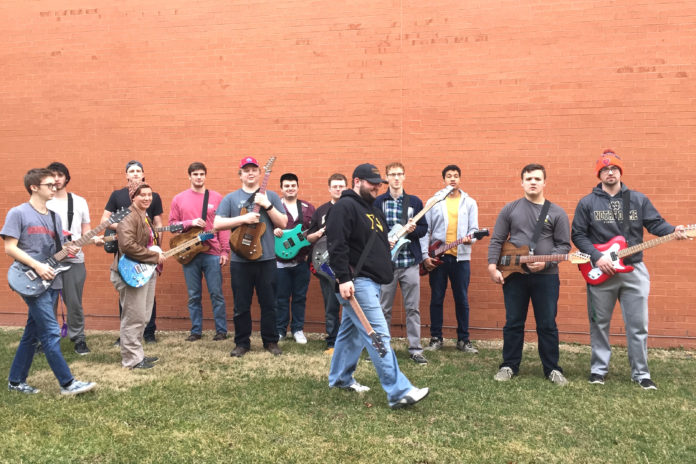
While some students spent the month of January abroad and others stayed at home, one group of DePauw students built their own electric guitars from scratch.
Guided by chemistry professors Daniel Gurnon and Rich Martoglio, sixteen students had the opportunity to craft their own guitar using basic STEM, woodworking and machining skills in Peeler’s sculpture lab.
Although the class may sound like a typical art course, much of the course was spent learning about scientific theories behind the guitar and the building process.
The course, titled Science, Design and Construction of the Electric Guitar, combines two areas of study into one class. “I think that it’s a great example of art and science, which is an important combination to me to show students the overlap,” Gurnon said.
Some students such as First-year Son Nguyen thought the class would be focused heavily on musical theory; instead, the class centered around how both mathematics and chemistry can coalesce to build objects, like a guitar. “We learned about how to calculate the position of the fret in the neck of the guitar to make the exact note,” said Nguyen in response to the mathematical side of the process.
First-year James McGuigan also discussed the importance of the engineering side and touched on what goes into the process of building something as complex as a musical instrument. He explained the process of cutting the wood, creating and designing the shape, as well as eventually staining and painting the outside of the guitar.
Although the course is taught at other colleges and universities, DePauw’s Winter Term course offered its students a unique opportunity for complete immersion into learning the fabrication of the electric guitar.
Winter Term courses allow students to take a break from their typical schedule and explore classes outside of their major. Both Nguyen and McGuigan explained that they had very little experience in woodworking but were extremely happy they pushed themselves and took the class.
In fact, most of Gurnon and Martoglio’s students had never built a guitar before, let alone used power tools. Despite the lack of experience, Gurnon hopes that the class has changed the way students look at objects and themselves. “I hope that they have a different attitude about their own capabilities, their own talents,” said Gurnon. “There’s some kind of larger goals there that have to do with transferable life skills.”
For McGuigan, while the class was “super out of the box” for him, the material introduced him to the professors in the biochemistry department. Meanwhile, Nguyen thought the professors would be from the music school but was incredibly surprised when learning they were biology and chemistry professors. “The professors of DePauw University are very talented,” said Nguyen “and they can work in a diverse range of interests and fields.”
This was the Science and Design of the Electric Guitar’s first year ever as a winter term course. There is no doubt in Gurnon’s mind that he will continue offering the course. “My dream really is to have the students build guitars out of supplies that have been sourced from Greencastle,” said Gurnon,
“We have a sawmill here. I would love to start with wood from that sawmill. We’ll do a few iterations of this course and it will change a little bit every time.”
Gurnon believes not only the class will succeed, but also that the students will grow after their experience with the course; he hopes the lessons they have learned will be useful throughout their lives. Going forward, Gurnon hopes to continue changing the perspectives of the students who take the class. “I hope that these students have more confidence and more acceptance of failure because failure can be a really good thing.”
